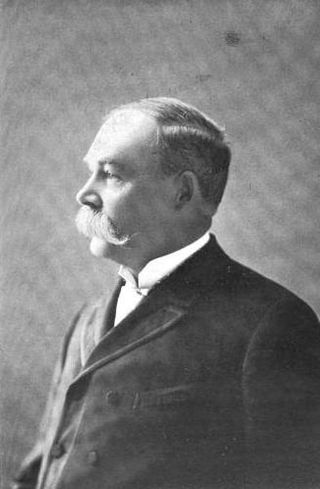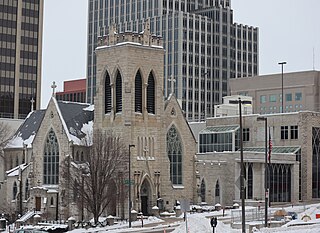
James Edward Boyd was an Irish-born American businessman and politician in early Omaha, Nebraska. The founder of Boyd's Packing House and Boyd's Theater and Opera House, he served as the Mayor of Omaha from 1881 to 1883 and from 1885 to 1887, and as the seventh Governor of the state of Nebraska in 1891 and from 1892 – 1893.

Albert Webb Jefferis was an American Republican Party politician.
Florence is a neighborhood in Omaha, Nebraska, United States on the city's north end and originally one of the oldest cities in Nebraska. It was incorporated by the Nebraska Territorial Legislature on March 10, 1857. The site of Winter Quarters for Mormon migrants traveling west, it has the oldest cemetery for people of European descent and oldest standing gristmill in Nebraska. Florence was the site of an illegal territorial legislature in 1858. Given the high concentration of National Register of Historic Places in the neighborhood, it is regarded as "the historic front door to Omaha as well as the state."
Significant events in the history of North Omaha, Nebraska include the Pawnee, Otoe and Sioux nations; the African American community; Irish, Czech, and other European immigrants, and; several other populations. Several important settlements and towns were built in the area, as well as important social events that shaped the future of Omaha and the history of the nation. The timeline of North Omaha history extends to present, including recent controversy over schools.

Fort Omaha, originally known as Sherman Barracks and then Omaha Barracks, is an Indian War-era United States Army supply installation. Located at 5730 North 30th Street, with the entrance at North 30th and Fort Streets in modern-day North Omaha, Nebraska, the facility is primarily occupied by the Metropolitan Community College. A Navy Operational Support Center and Marine Corps Reserve unit, along with an Army Reserve unit occupy the periphery of the 82.5 acres (33.4 ha) fort. The government deeded all but four parcels of the land to the Metropolitan Community College in 1974.

The Prospect Hill Cemetery, located at 3202 Parker Street in the Prospect Hill neighborhood of North Omaha, Nebraska, United States, is believed to be the oldest pioneer cemetery in Omaha. It is between 31st and 33rd Streets and Parker and Grant Streets.

St. John African Methodist Episcopal Church was the first church for African Americans in Nebraska, organized in North Omaha in 1867. It is located at 2402 North 22nd Street in the Near North Side neighborhood. The building is listed on the National Register of Historic Places. The building was constructed in the center of Omaha's North Side in the Prairie School architecture style. Prairie School architecture is rare, and this architectural gem in urban Nebraska is particularly unusual for being designed and built in the 1920s, after the Prairie Style's rapid loss of popularity beginning after 1914.

Holy Family Church was built in 1883 at 1715 Izard Street, at the intersections of 18th and Izard Streets in North Omaha, Nebraska within the Roman Catholic Archdiocese of Omaha. It is the oldest existing Catholic Church in Omaha, and is listed on the National Register of Historic Places.

The Mormon Pioneer Cemetery is located at 3300 State Street in present-day Florence at the north end of Omaha, Nebraska. The Cemetery is the burial site of hundreds of Mormon pioneers who lived in Winter Quarters, a temporary settlement that lasted from 1846 to 1848 as the settlers moved to Salt Lake City, Utah. It was designated a landmark by the City of Omaha in 1990.

Frederick Metz (1832–1901) founded and owned the Metz Brewery in Omaha, Nebraska, for forty years. He was also a two-time representative in the Nebraska Legislature, and an influential member of Omaha society.

Anna Wilson was a pioneer madam in Omaha, Nebraska. When she died she bequeathed her life savings to the City of Omaha, along with her 25-room mansion brothel, which was used as a hospital. Wilson was responsible for "establishing Omaha's first serious comfort station", and was known as the "Queen of the Underworld."

Temple Israel Cemetery, also known as Pleasant Hill Cemetery, is located at 6412 North 42 Street in the North Omaha neighborhood of Omaha, Nebraska.
Fisher Farm Cemetery, including the B'nai Abraham Cemetery, the Hrabik Cemetery, the Beth Hamedrosh Hagadol Cemetery, and Bnai Abraham Cemetery, is located at 8600 South 42 Street in Bellevue, Nebraska.
Czechs in Omaha, Nebraska have made significant contributions to the political, social and cultural development of the city since the first immigrants arrived in 1868.

Trinity Cathedral is located in Downtown Omaha, Nebraska. Nebraska's first Episcopal parish, Trinity was established in 1856, and became the state's first Episcopal cathedral in 1872. Designed by noted English architect Henry G. Harrison in 1880, the cathedral was consecrated on November 15, 1883. It was added to the National Register of Historic Places in 1974. Today Trinity Cathedral is considered one of the most beautiful churches in Omaha.

St. Martin of Tours Episcopal Church is a historic stone Episcopal church building located at 2312 J Street in the South Omaha district of Omaha, Nebraska. Built in 1899 in the Late Gothic Revival style, it was designated an Omaha Landmark and listed on the National Register of Historic Places in 1982. It was the first Episcopal church established in South Omaha when the town was being developed. It is the only surviving Episcopal church in this community, which was settled chiefly by Catholic immigrants.
Danish Brotherhood in America is a fraternal organization that was founded in 1882 in Omaha, Nebraska. It had about 8,000 members in 2010. A period report said of the Danish Brotherhood, "This is by far the strongest and most influential secular organization about the Danes in America."
The Danish people in Omaha, Nebraska, were a predominant ethnic group in the city in the 1920s, and were notable for that compared to other cities across the United States. Omaha, as well as its neighbor, Council Bluffs, had "major colonies of Danes for many years."
Significant events in the history of Omaha, Nebraska, include social, political, cultural, and economic activities.
Springwell or Springwells may refer to:












